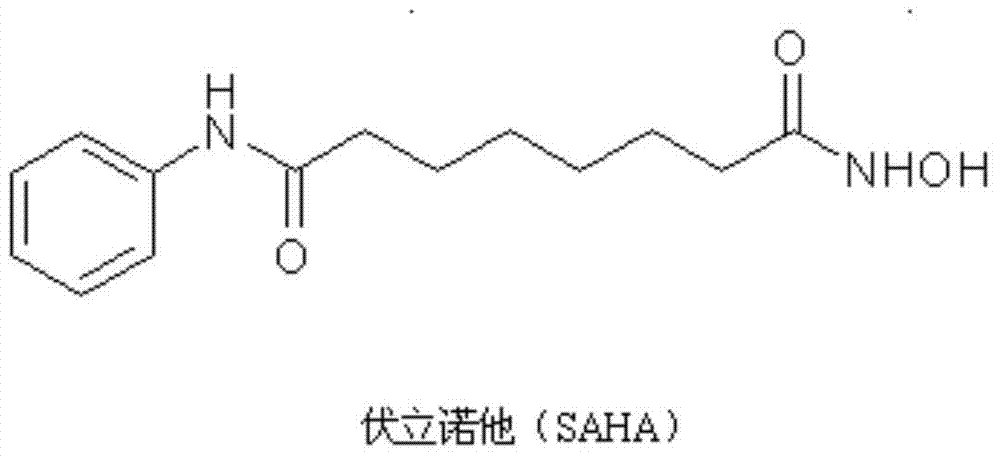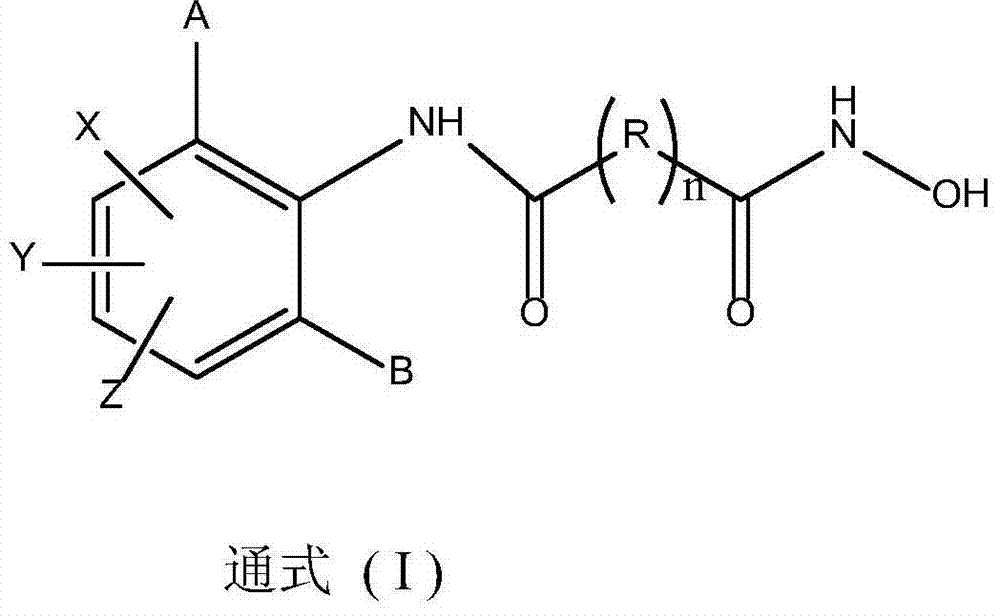Hydroxamic acid compounds and application thereof in preparation of medicines for inhibiting cancer cell proliferation and/or treating cancers
The technology of a compound and hydroxamic acid is applied in the field of hydroxamic acid compounds and their application in the preparation of drugs for inhibiting cancer cell proliferation and/or treating cancer, and can solve the problem that condensing agents and adjuvants are expensive and unreachable. effects, environmental pollution, etc.
- Summary
- Abstract
- Description
- Claims
- Application Information
AI Technical Summary
Problems solved by technology
Method used
Image
Examples
Embodiment 1
[0051] Preparation of N-(3,4-dimethylphenyl)-N'-hydroxysuberamide (abbreviated as B113).
[0052] Step (1): Weigh 1.21g (10mmol) of 3,4-dimethylaniline, 1.88g (10mmol) of monomethyl suberate, and 0.31g (5mmol) of boric acid into a 100ml three-neck round bottom flask, and add 30ml of toluene , nitrogen protection, magnetic stirring, heating the oil bath to toluene reflux, using a water separator to separate the water generated in the reaction process, filling the water separator with toluene before the reaction, the reaction time is 10h, and tracking with a thin layer chromatography plate during the reaction For the reaction, the developer is ethyl acetate:petroleum ether=1:1. After the reaction is completed, pour the reaction solution into 300ml of petroleum ether under stirring. After stirring for 0.5h, vacuum filter the solid with a sand core funnel, and wash the solid with water to remove the catalyst boric acid, and then wash it with petroleum ether after draining. solid ...
Embodiment 2
[0055] Preparation of N-(3-chloro-4-fluorophenyl)-N'-hydroxysuberamide (hydroxamic acid) (referred to as B115).
[0056] Step (1): Weigh 1.46g (10mmol) of 3-chloro-4-fluoroaniline, 1.88g (10mmol) of monomethyl suberate, and 0.31g (5mmol) of boric acid into a 100ml three-neck round bottom flask, and add 30ml of toluene , nitrogen protection, magnetic stirring, heating the oil bath to toluene reflux, using a water separator to separate the water generated during the reaction, filling the water separator with toluene before the reaction, the reaction time is 12h, and tracking with a thin layer chromatography plate during the reaction For the reaction, the developer is ether:petroleum ether=1:1. After the reaction is completed, pour the reaction solution into 300ml of petroleum ether under stirring. After stirring for 0.5h, vacuum filter the solid with a sand core funnel, and wash the solid with water to remove the catalyst boric acid, and then wash it with petroleum ether after d...
Embodiment 3
[0059] Preparation of N-(3-bromo-5-trifluoromethylphenyl)-N'-hydroxysuberamide (referred to as B123).
[0060] Step (1): Weigh 0.8g (3.33mmol) of 3-bromo-5-trifluoromethylaniline, 0.63g (3.33mmol) of monomethyl suberate, and 0.10g (1.67mmol) of boric acid in a 100ml three-port circle Bottom flask, add 30ml toluene, nitrogen protection, magnetic stirring, oil bath heating to toluene reflux, use water separator to separate the water generated in the reaction process, before the reaction, the water separator is filled with toluene, the reaction time is 20h, during the period use The reaction was followed by thin-layer chromatography, and the developing solvent was ether:petroleum ether=1:1. After the reaction is completed, pour the reaction solution into 300ml of petroleum ether under stirring. After stirring for 0.5h, vacuum filter the solid with a sand core funnel, and wash the solid with water to remove the catalyst boric acid, and then wash it with petroleum ether after drain...
PUM
 Login to View More
Login to View More Abstract
Description
Claims
Application Information
 Login to View More
Login to View More - R&D
- Intellectual Property
- Life Sciences
- Materials
- Tech Scout
- Unparalleled Data Quality
- Higher Quality Content
- 60% Fewer Hallucinations
Browse by: Latest US Patents, China's latest patents, Technical Efficacy Thesaurus, Application Domain, Technology Topic, Popular Technical Reports.
© 2025 PatSnap. All rights reserved.Legal|Privacy policy|Modern Slavery Act Transparency Statement|Sitemap|About US| Contact US: help@patsnap.com



